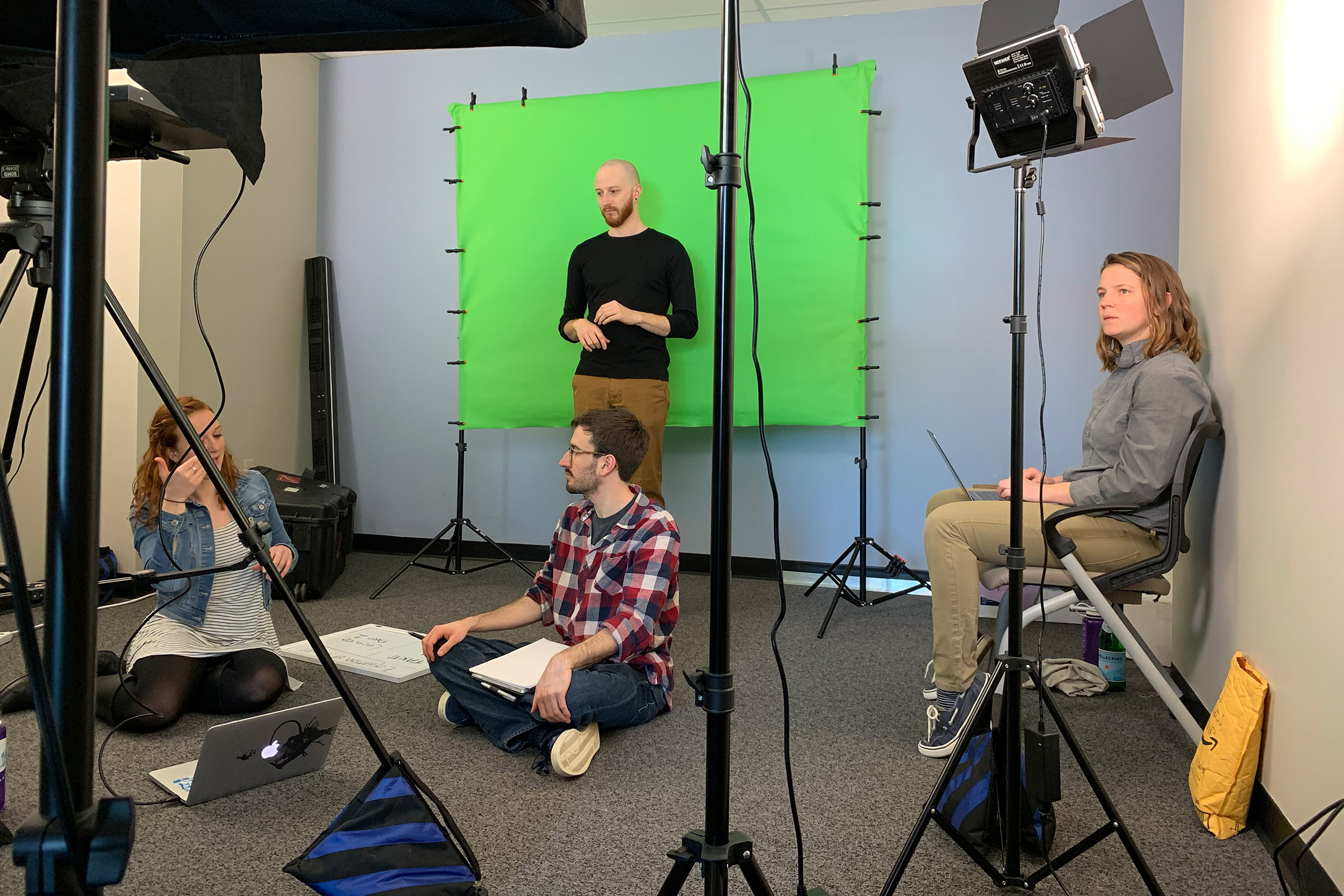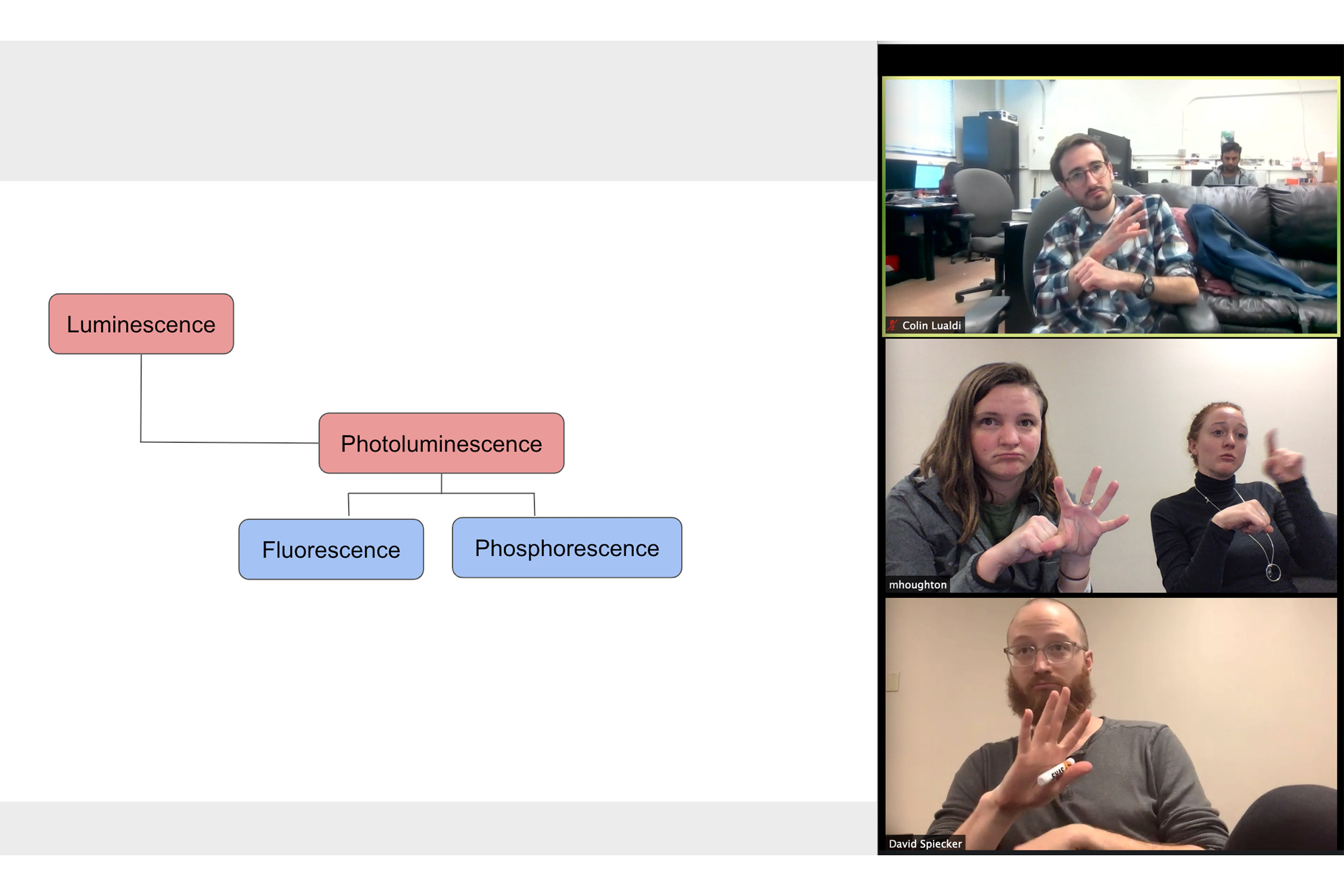
Mandy Houghton (right) and members of the team during a video production project to develop educational modules in American Sign Language for quantum science topics.
Photo courtesy of Mandy Houghton
Signs of quantum science
Collaborative project creates quantum science terms in American Sign Language
You are sitting in a Harvard classroom ready for a quantum science lecture to begin. The professor steps behind the podium and begins her presentation: “The a-n-g-u-l-a-r f-r-e-q-u-e-n-c-y indicates how often a single p-a-r-t-i-c-l-e in the wave oscillates in time.”
Following and understanding a concept presented this way, with the professor spelling out each word, would add a whole level of difficulty to an already complex topic.
This scenario is exactly what deaf people experience on a daily basis. Because signs in American Sign Language (ASL) do not exist for many STEM concepts, interpreters are forced to fingerspell words in an effort to communicate concepts, forcing a deaf person to channel between ASL and English to make sense of topics discussed.
This can be exhausting and makes learning the content far more challenging than for other students.
A collaboration between Harvard’s Center for Integrated Quantum Materials (CIQM) and The Learning Center for the Deaf (TLC) is attacking this challenge, with the aim of increasing STEM opportunities for deaf and hard-of-hearing students.
The project is led by Mandy Houghton, a former science teacher at the Florida School for the Deaf who first got involved during a summer internship at CIQM, part of the Harvard John A. Paulson School of Engineering and Applied Sciences. Houghton was so impressed by how well the Harvard interpreters were able to convey the complex science concepts that she asked them where they learned the signs.
That led her to a group at Boston University, which was working to create content and new signs for as many STEM topics as possible.
As a deaf high school teacher, Houghton knew being able to accurately discuss more STEM topics in ASL could go a long way toward supporting deaf and hard-of-hearing students and inspiring them to consider careers in the field. Houghton became so passionate about the issue she left teaching and joined the project as manager.
Houghton and the team of deaf STEM experts began by generating ASL content for middle and high school biology, but National Science Foundation (NSF) funding to CIQM she shifted her focus to developing ASL modules on quantum science topics for undergraduate students.

The team discusses technical quantum science terms during a Zoom meeting.
Photo provided by Mandy Houghton
Contributing to the project is a natural fit for CIQM, which has focused on providing opportunities for students who are under-represented in STEM fields through its summer internship program, said Naomi Brave, CIQM managing director. Gallaudet University, Houghton’s alma mater and the nation’s preeminent postsecondary institution for the education of the deaf and hard of hearing, is one of CIQM’s partner schools. Input from Gallaudet interns has been invaluable to this project, Brave said.
“We realized this was something we could really help with, so we applied for a supplemental funding grant from the NSF, and got some money that we used to interview all of our past Gallaudet interns and all of their mentors and the faculty in the labs they worked in and came up with an extensive glossary of terms that were problematic for them,” Brave said. “One of the things that is very important to us in our education program is to provide equal opportunity for everybody.”
After conducting a needs assessment, interviewing the interns, and generating that glossary of terms, Houghton and her colleagues got to work developing educational modules. The glossary helped them identify terms to discuss and continues to serve as a guide for the work.
To develop educational modules, they begin by determining which quantum science topics to address. Then, the team determines the order in which content should be presented and how different terms are connected.
There are often fundamental topics that are discussed in lieu of highly technical information. If the team wants to discuss that highly technical information in ASL, they must also address many of these more basic related ideas that are not conceptually available in ASL.
They search for existing ASL terms, determine whether they are conceptually accurate for the topic and, if not, get to work crafting new signs.
Developing new signs is a complex process. They must consider a new sign in its specific scientific context, explore different root words that might be included, and make connections based on the meanings of the term.
They then develop scripts for videos that teach those concepts. If there are new signs to be filmed, they document them especially carefully to explain the context and elements of the sign itself.
While the COVID-19 pandemic has slowed their in-person progress, the team is converting the filmed material to video this spring and will be posting on a distinct YouTube Channel.
“Testing a new sign and collecting feedback within our community is the most critical piece of the process because language is a living thing and it relies on the users adopting and utilizing the sign,” Houghton said. “When the community adopts the new ASL signs, it shows people find these signs natural, intuitive, and useful when engaging in STEM conversations, which is the main aim of this work.”
She is excited to share the team’s work with the world and continue to expand their efforts, focusing on different science content areas and ramping up community engagement so others understand the challenges faced by deaf and hard-of-hearing students. Ultimately, she hopes the work creates more STEM opportunities for students who communicate using ASL.
For more information about the project, contact Mandy Houghton at mhoughton@tlcdeaf.org.








